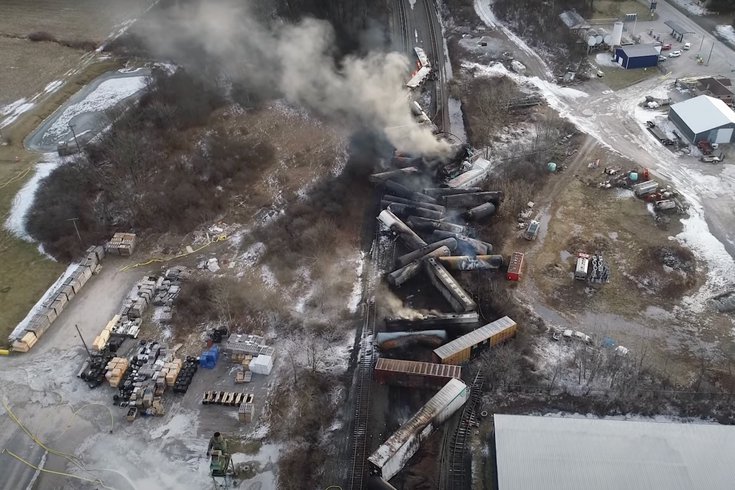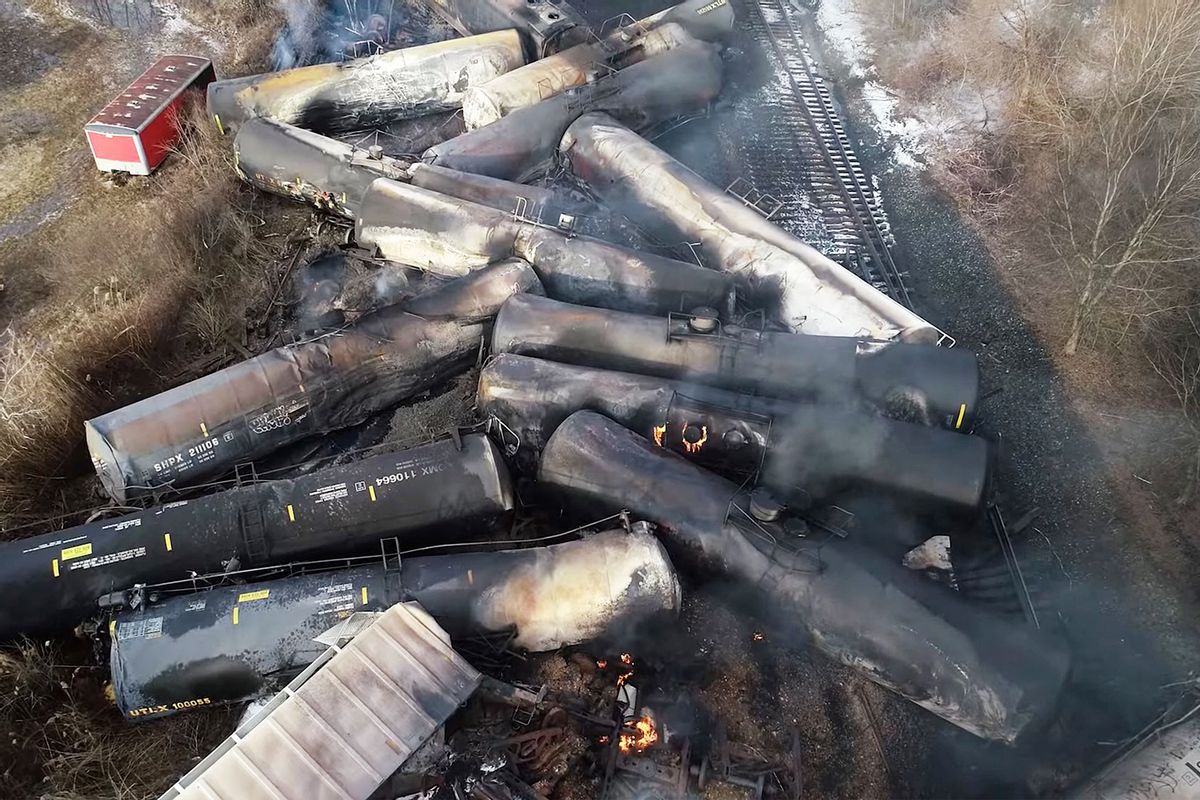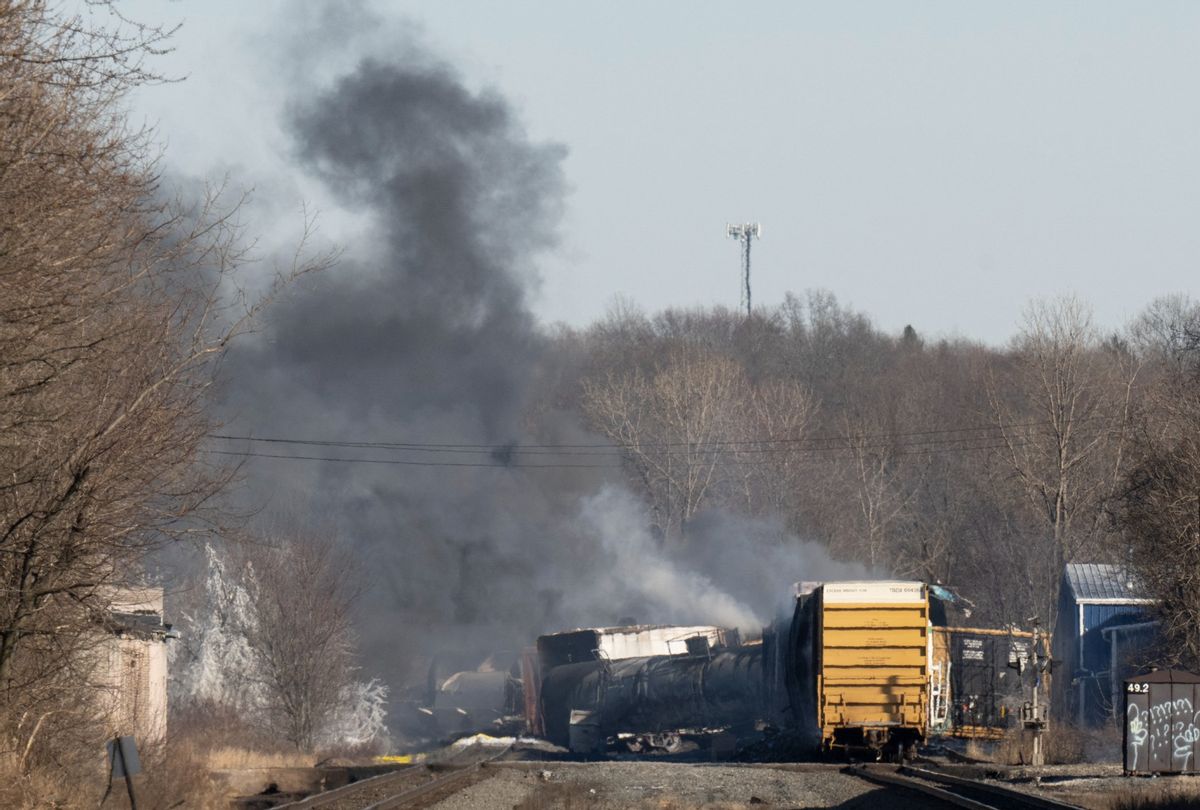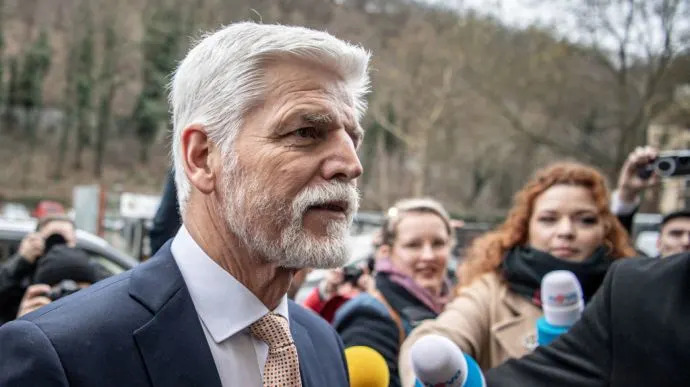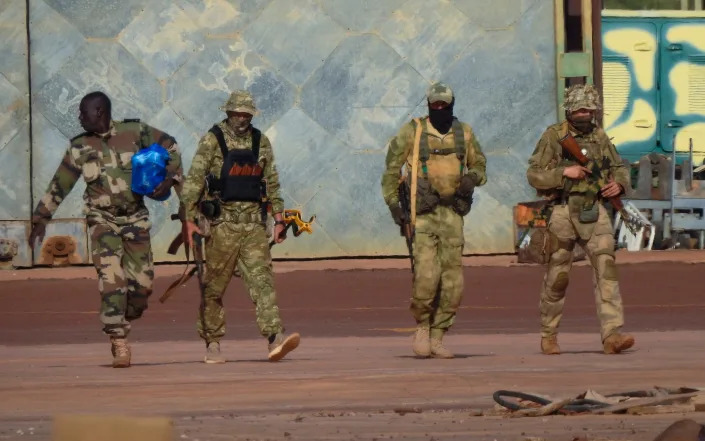Brad Martin and Aaron Clark-Ginsberg
Sun, February 19, 2023

Portions of a Norfolk Southern freight train that derailed in East Palestine, Ohio, were still on fire on Feb. 4, the day after the accident. (Gene J. Puskar / Associated Press)
Earlier this month, a threat with potentially serious consequences for the long-term national security of the United States presented itself — and not in the form of a high-altitude balloon.
It was a railroad derailment, in East Palestine, Ohio, which resulted in a discharge of vinyl chloride, a cancer-causing substance that response crews burned in order to prevent an explosion. Many organizations, including those responsible for the safety and well-being of the citizens of East Palestine, might not have viewed this incident as a national security issue. But it is, and as such, requires a more vigorous response, and certainly more attention than the spy balloon or balloons.
Consider, for starters, that “national security” encompasses not merely the external defense of the United States, but also the intelligence apparatus that supports its military operations, the defense against terrorist attacks, and the diplomatic efforts to secure allies and communicate with potential adversaries. All these actions and a variety of others are what nations do to protect their citizens. And while these actions are generally viewed apart from the things a nation does to promote prosperity and well-being among its people, they cannot be separated.
National security is about protecting a nation and its people and their well-being. Which means that certain aspects of infrastructure and services are so fundamental to this effort — fundamental to the very functioning of society — that their continued ability to function is also considered a national security issue.
A secure food supply, for example. Or energy supplies, public safety or protection against environmental threats. Yet last week residents of East Palestine were drinking only bottled water; livestock and fish are dying suddenly; the possible health and environmental outcomes, though they remain unknown, are quite possibly dire.
The rail disaster was not the result of an external attack, and although the specific reasons for the accident are still under investigation, it is no stretch to imagine that it was a slow-moving, internally created disaster of neglected infrastructure, leaner staffing models and watered-down safety requirements — a string of decisions favoring efficiency over safety, all resulting in the routing of hazardous cargo through places where people live. The implications of this disaster will no doubt unfold over decades, with invisible contamination hitting already vulnerable people and environments, and lingering long after the cleanup crews leave.
This disaster is not unique, either, but of a piece with many other slow-moving disasters, such as the water crises in Flint, Mich., and in Jackson, Miss.; or the Deepwater Horizon and Taylor oil spills; or the countless other unnamed and underreported disasters that tend to strike communities with already high levels of poverty, substance abuse and addiction, and poor health, as well as growing risk to greater climate shocks and stresses.
But the symptoms of the United States’ degraded infrastructure, as well as its dangerous practices of routing hazardous cargo through population centers, and its inadequately staffed response crews, highlight a troubling national security issue, too — one that would make mobilization for a major international response slow and precarious. If such systems and capabilities are already at a ragged edge during peacetime, in wartime they would likely collapse, the potential impact of which is likely far greater than whatever intelligence the systems on a high-altitude balloon might have collected.
This is not to dismiss airspace intrusions, but rather to suggest that collective attentions might be misplaced. The slow degradation of infrastructure and disaster response is less a spectacle than an overflying balloon, but the train derailment and chemical spill in Ohio has highlighted just how bizarre such a focus on perceived external national security threats has become. The far greater threat may be from within.
The defense and intelligence agencies will no doubt appropriately evaluate the threats from balloon overflights. Meanwhile, how to reduce the risk of the slow disasters unfolding with greater frequency and increasing severity is already well known. It takes investing in decaying infrastructure and hiring people to run and maintain it. It requires beefed-up safety regulations, a stronger social safety net and adequate funding for public health. These, too, are national security issues — ones that may be considerably more immediate than defense against airborne intelligence collection.
Brad Martin is a senior policy researcher at the nonpartisan, nonprofit Rand Corp. and the director of the Rand National Security Supply Chain Institute.
Aaron Clark-Ginsberg is a social scientist at Rand and a professor of policy analysis at Pardee Rand Graduate School.
This story originally appeared in Los Angeles Times.
White House defends response to Ohio toxic train derailment

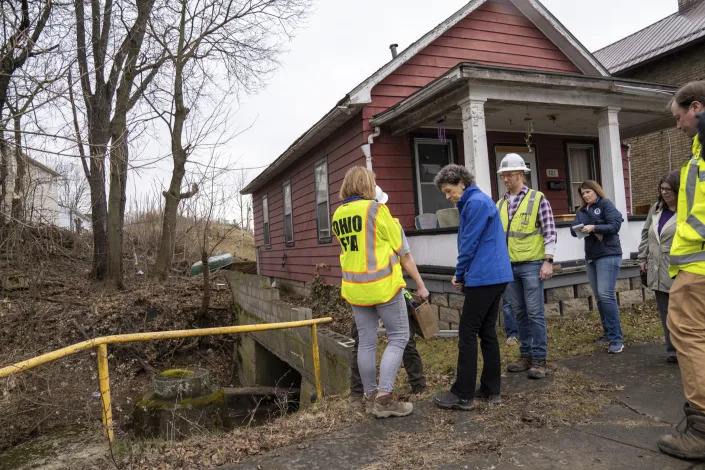

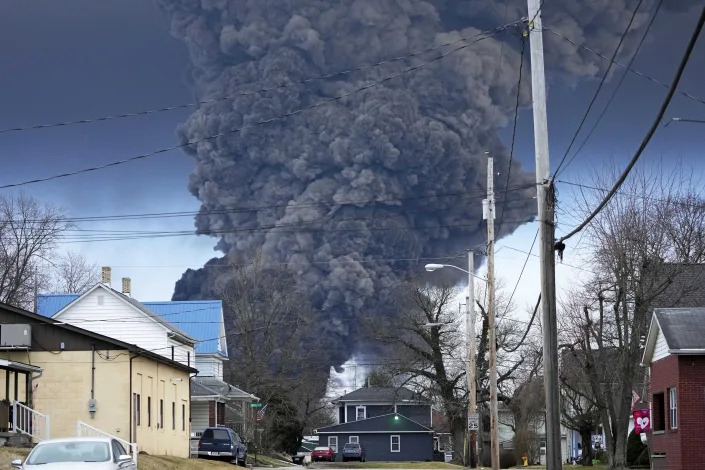
MATTHEW DALY
Fri, February 17, 2023
WASHINGTON (AP) — The Biden administration on Friday defended its response to a toxic freight train derailment in Ohio two weeks ago, even as local leaders and members of Congress demanded that more be done.
The Feb. 3 derailment in East Palestine, Ohio, left toxic chemicals spilled or burned off, prompting evacuations and fears of contamination by wary residents distrustful of the state and federal response.
The White House said it has "mobilized a robust, multi-agency effort to support the people of East Palestine, Ohio,'' and noted that officials from the Environmental Protection Agency, National Transportation Safety Board and other agencies were at the rural site near the Pennsylvania line within hours of the derailment of the Norfolk Southern train carrying vinyl chloride and other toxic substances.
“When these incidents happen, you need to let the emergency response take place,'' White House press secretary Karine Jean-Pierre said Friday. “We did take action and folks were on the ground.''
EPA Administrator Michael Regan visited the site Thursday, walking along a creek that still reeks of chemicals as he sought to reassure skeptical residents that the water is fit for drinking and the air safe to breathe.
“I’m asking they trust the government,” Regan said. “I know that’s hard. We know there’s a lack of trust.” Officials are “testing for everything that was on that train,” he said.
No other Cabinet member has visited the rural village, where about 5,000 people live, including many who were evacuated as crews conducted a controlled burn of toxic chemicals from five derailed tanker cars that were in danger of exploding.
Administration officials insisted their response has been immediate and effective.
“We’ve been on the ground since February 4 ... and we are committed to supporting the people of East Palestine every step of the way,'' Jean-Pierre said.
Transportation Secretary Pete Buttigieg, who has faced criticism from lawmakers and the mayor of East Palestine for not visiting the site, said the Ohio disaster was just one of many derailments that occur each year. A train hauling hazardous materials derailed Thursday near Detroit, but none spilled, officials said.
"There's clearly more that needs to be done, because while this horrible situation has gotten a particularly high amount of attention, there are roughly 1,000 cases a year of a train derailment,'' Buttigieg told Yahoo Finance.
He tweeted Friday that his department “will hold Norfolk Southern accountable for any safety violations found to have contributed to the disaster” and will be guided by the findings of the transportation safety board's independent investigation.
President Joe Biden has offered federal assistance to Ohio Gov. Mike DeWine and Pennsylvania Gov. Josh Shapiro, and the Federal Emergency Management Agency has been coordinating with the state emergency operations center and other partners, the White House said.
In response to a request from DeWine and Ohio's congressional delegation, the Health and Human Services Department and Centers for Disease Control and Prevention are sending a team of medical personnel and toxicologists to Ohio to conduct public health testing and assessments.
The team will support federal, state and local officials already on the ground to evaluate people who were exposed or potentially exposed to chemicals, officials said.
Since the derailment, residents have complained about headaches and irritated eyes and finding their cars and lawns covered in soot. The hazardous chemicals that spilled from the train killed thousands of fish, and residents have talked about finding dying or sick pets and wildlife.
Residents also are frustrated by what they say is incomplete and vague information about the lasting effects from the disaster, which prompted evacuations.
Regan said Thursday that anyone who is fearful of being in their home should seek testing from the government.
“People have been unnerved," he said. “They’ve been asked to leave their homes.” He said that if he lived there, he would be willing to move his family back into the area as long as testing shows it’s safe.
Sen. Joe Manchin, D-W.Va., said he was glad that Regan visited the site, but called it "unacceptable that it took nearly two weeks for a senior administration official to show up'' in Ohio.
Sen. Sherrod Brown, D-Ohio, who toured the crash site with Regan on Thursday, said he spoke with Biden on Friday and was assured that any assistance the state needs will be given.
“The president is all in on getting FEMA" to provide direct assistance and is "all-in on holding Norfolk Southern accountable,'' Brown told an online news conference.
Ohio state Sen. Michael Rulli, a Republican whose district includes East Palestine, said Buttigieg should resign over the Transportation Department’s inaction. “He has not even come close to being near ground zero and he should be ashamed,” Rulli said.
Rep. Bill Johnson, R-Ohio, who toured the site with Regan and Brown on Thursday, has generally supported the federal response but joined other Ohio officials in calling for more help from FEMA. Johnson sent a letter Friday asking EPA to provide detailed information about the derailment, including the controlled burn conducted last week and testing plans for air and water quality.
“The community must be able to trust their air, water, and soil is not a threat to their health following this train derailment," Johnson said.
David Masur, executive director of PennEnvironment, said there's been a "breach of public trust” in the wake of the disaster, stemming from lax oversight of freight rail and weak notification requirements for hazardous cargo, as well as lingering uncertainties about air and water quality and whether evacuated residents were allowed to return home too soon.
“Because there have been so many missteps, you can understand that the public is skeptical,’’ said Masur, who co-authored a report that detailed risks that trains carrying explosive and toxic materials pose to nearby communities. The report came after a 2015 CSX oil train disaster near Mount Carbon, West Virginia. A train derailed, exploded and burned for days, contaminating the Kanawha River.
While Regan’s visit was helpful, officials need to offer more than words or sympathy — and instead implement policies to protect the public health and prevent this from happening again, he said.
____
Associated Press writer Patrick Orsagos in East Palestine, Ohio, contributed to this story.




A man raises his hand with a question for East Palestine, Ohio Mayor Trent Conaway, center, during a town hall meeting at East Palestine High School in East Palestine, Ohio, Wednesday, Feb. 15, 2023. The meeting was held to answer questions about the ongoing cleanup from the derailment on Feb, 3, of a Norfolk Southern freight train carrying hazardous material. (AP Photo/Gene J. Puskar)
